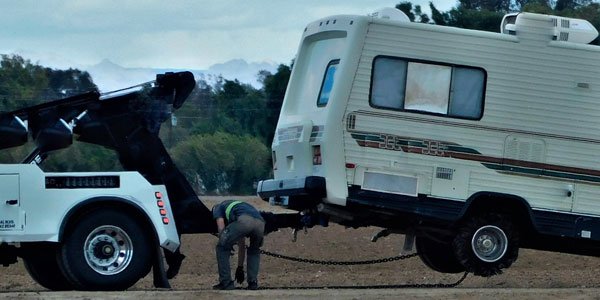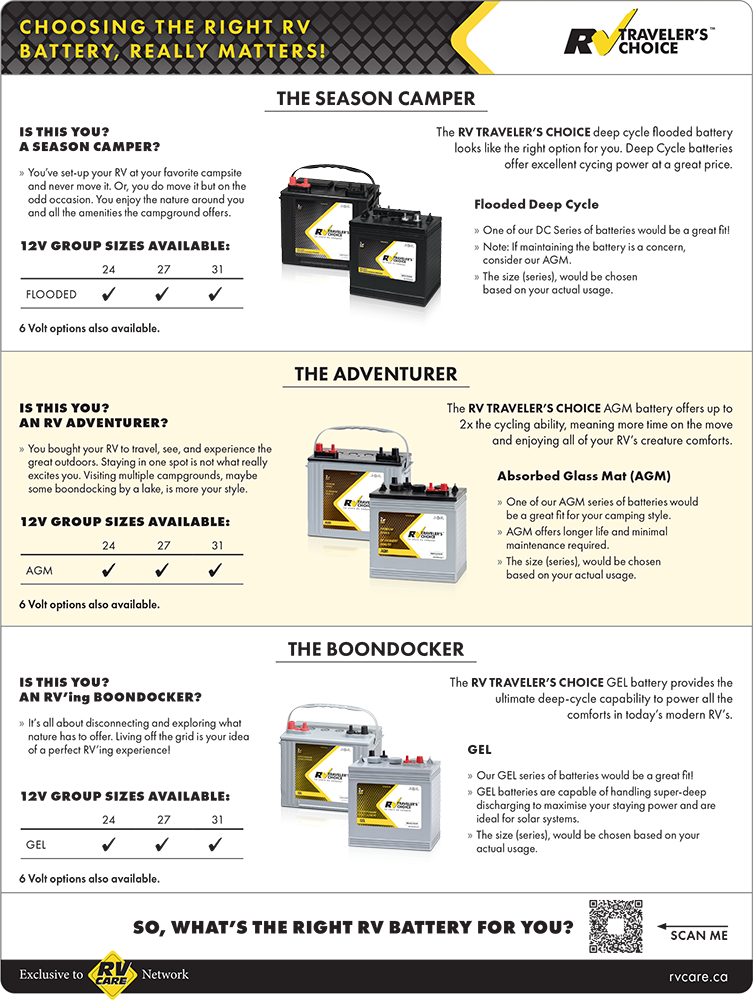RV BATTERY SYSTEM
Travel Trailers and Motorhomes come in a multitude of sizes, with varying on-board devices that require different levels of power.
Therefore, understanding your RV’s specific power requirements based on your RVing lifestyle is crucial for determining the correct battery system.
ARE YOUR BATTERY SYSTEMS IN CHECK?
HERE ARE 5 QUESTIONS YOU NEED TO ASK YOURSELF
1. Are your batteries “deep cycle” batteries optimized for RVs?
Batteries may look the same on the outside, but they can be very different on the inside.
That’s why it’s critically important you only use deep cycle batteries to power your RV’s on-board equipment and electronics.
Automotive-style batteries used for engine starting are not designed to support the sustained power draws of fridges, microwaves, TVs, satellite dishes, electric pumps, cell phone chargers and everything else that plugs in and turns on inside your RV.
RV Care Traveler’s Choice deep cycle batteries are optimized for RV use.
They will last much longer and deliver more reliable performance than regular automotive batteries.
For larger RVs with many electronic devices tied into your battery system, our AGM and gel batteries will provide a more premium power solution to support those extra power demands.
AGM and gel batteries are completely interchangeable with regular flooded batteries, and their fully sealed, never add water design eliminates the need for periodic watering.
2. Does your battery system have enough capacity to meet your needs?
If you will have access to AC power to recharge your battery system, this question is not as critical as if you were going completely “off the grid”.
If your battery system is not large enough to accommodate your power needs, your family could suddenly be left in the dark.
No one wants to end their holiday like that!
As a rule of thumb, your battery system should have enough capacity to provide at least twice the expected power draw required before the batteries will be recharged.
Your RV Care Dealer can help you estimate your power demands and recommend the right sized battery system to ensure you have adequate power throughout your entire trip.
To maximize battery life, your battery system should not be discharged more than 50% between recharges.
That’s why it’s good practise to fully recharge your battery system after every trip, regardless of how long the batteries were in use.
3. Do your batteries pass a visual inspection?
It’s always a good idea to do a quick check of your battery system before heading out on the road. A little preventive maintenance ahead of your trip will help ensure a safe and hassle-free vacation*.
Here is a quick checklist of things you should visually check to help ensure your batteries are in good working order.
- Are the battery terminals clean so that there’s a solid connection between terminal and cable leads? If not, apply a mixture of baking soda and water to the terminals (and cable leads if necessary) and scrub lightly with a wire brush. Maintaining a clean, solid connection will ensure the batteries are able to operate at peak efficiency.
- Is the top of each battery reasonably clean? If not, wipe away any dust and grime with a warm water and baking soda. Otherwise, moisture droplets on the dirt could create a conductive electrical pathway that causes the battery to continuously discharge. Keeping battery tops clean will help ensure you obtain maximum performance and life from your battery system.
- Is the case and cover of each battery free of damage? Batteries with cracked and/or leaking cases should be replaced as soon as possible.
- Bulging batteries can indicate blocked safety vents. If your vents are clear and your flooded battery begins bulging outwards during charging, discontinue charging immediately and replace the battery. (Bulging in AGM batteries during or after recharge is not necessarily cause for concern. These batteries are fully sealed and so a difference between internal battery pressure and the outside environment can cause an AGM battery to have a slight convex or concave appearance. This is perfectly normal, unless the bulging is severe.)
- Are the battery terminals clean so that there’s a solid connection between terminal and cable leads? If not, apply a mixture of baking soda and water to the terminals (and cable leads if necessary) and scrub lightly with a wire brush. Maintaining a clean, solid connection will ensure the batteries are able to operate at peak efficiency.
*Important note: When handling batteries be sure to wear protective gloves and eyewear. Battery electrolyte is highly acidic and can burn through skin and clothing. If the electrolyte should contact skin or eyes, flush extensively with large quantities of cool water and seek medical attention as soon as possible.
4. Is your battery maintenance up to date?
Flooded deep cycle batteries can lose some of their water through evaporation as the battery heats up during the recharge process.
This is part of a flooded battery’s normal operation, but it means that the water level inside each battery cell must be checked on a regular basis and topped up as necessary*.
Always use distilled water and never add water past the fill line inside each battery cell.
ALWAYS add water to a battery after it has fully recharged and cooled down. NEVER add water to a battery before recharging it.
The water level will rise as the battery is being charged, so adding water while the battery is discharged could cause it to overflow and lose some of its acid during the recharge process.
This will reduce the power-generating capability of the battery.
IMPORTANT: Never check the water levels of a battery before the battery has fully cooled. Recharging a battery causes it to heat up. Removing a vent cap to access the water reservoir could therefore cause the battery to spew acid and cause serious injury.
NEVER CHARGE A FROZEN BATTERY. Doing so may cause the battery to explode. Always allow a battery to come up to room temperature before recharging it.
*Important note: When handling batteries be sure to wear protective gloves and eyewear. Battery electrolyte is highly acidic and can burn through skin and clothing. If the electrolyte should contact skin or eyes, flush extensively with large quantities of cool water and seek medical attention as soon as possible.
Note that AGM and gel batteries are fully sealed and maintenance-free, which means they never need to be watered. These batteries are therefore a great alternative to regular flooded batteries for individuals who are not comfortable with working around batteries.
5. How old are your batteries?
How long your batteries will last depends on many factors, including how often you use them, how much power is removed from them on a regular basis, their average operating temperature, how they are maintained and how they are stored during the off-season.
On average, you can expect your battery system to last 2-3 years or perhaps longer when properly sized for your needs and adequately maintained.
If your batteries are two years or older, we recommend you ask your local RV Care Dealer to check battery state of health at the beginning of each season, as well as on every service visit. They can give you a reliable estimate of how much longer you can expect your batteries to last.
For larger RVs with many electronic devices tied into your battery system, our AGM and gel batteries will provide a more premium power solution to support those extra power demands. This helps extend battery service life so that you get the best value for your power investment.
We hope these questions provided you with the important and necessary information you’ll need before heading out on your next trip. If you need to replace your RV batteries, RV Care Dealers are there ready to assist you.
RV BATTERY RECYCLING
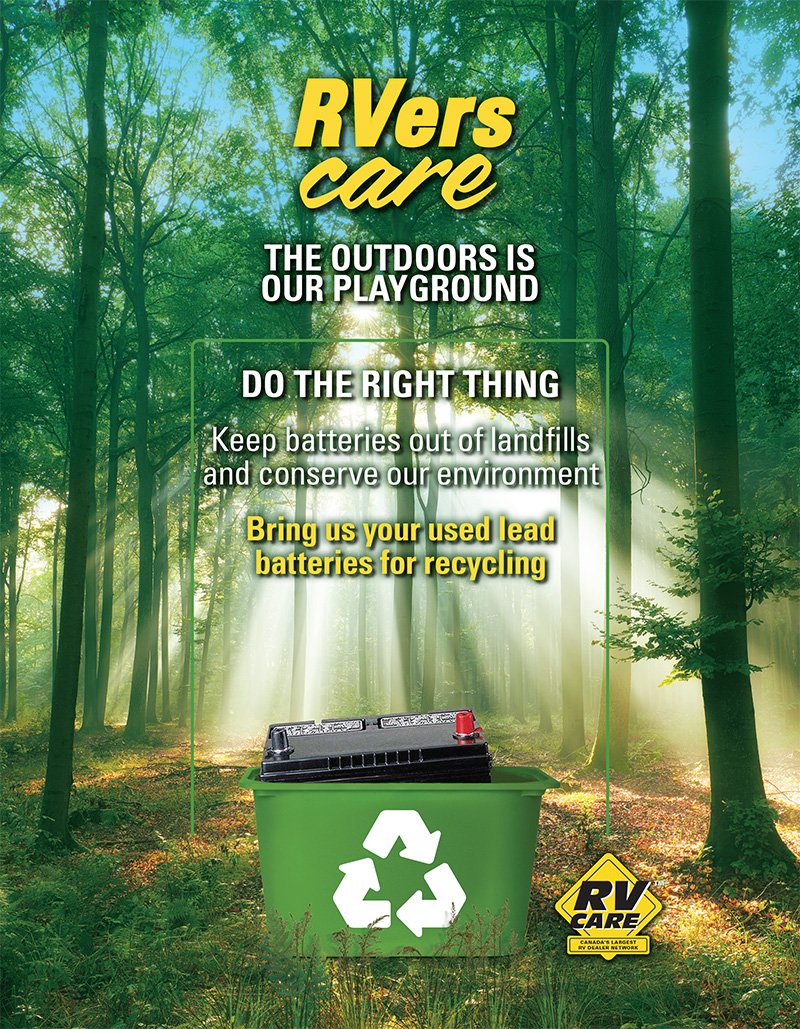
Let’s keep batteries out of our Canadian landfills. When you purchase RV Traveler’s Choice batteries, you can return your used RV batteries for a $15 credit per battery, which you can put towards the cost of your new battery.
WHY RECYCLE? THE FUTURE BELONGS TO ALL OF US!
Did you know that lead batteries are the most recycled consumer good on the planet – more than glass, paper or plastic!
Not only that, but virtually 100% of a lead battery is fully recyclable.
When you bring your used battery to an RV Care dealer, you are contributing to a great cause.
Together we can keep batteries out of landfills and conserve our environment.
WINTER RV BATTERY STORAGE
When storing your battery over the winter months, you need to minimize the degree of discharge in order to keep it in good working order.
Here are a few simple storage procedures you can follow that will extend the life of your battery:
Remove any corrosion using a mixture of baking soda and water, and then clean and dry the top of the battery. This will eliminate potential discharge paths.
- Terminals can be cleaned with a wire brush to remove remaining traces of corrosion.
- If the battery is being stored in a vehicle, disconnect it to avoid self-discharge due to parasitic loads such as clocks, ground faults, etc.
- Fully charge your battery before putting it into storage.
- If the battery has removable vent caps, check the electrolyte (battery fluid) level in each cell. If required, add distilled* water to bring the fluid level to just below the filler tube. CHARGE THE BATTERY PRIOR TO TOPPING UP THE ELECTROLYTE, otherwise electrolyte expansion during the charging process could cause the fluid to overflow. *Using regular tap water may introduce contaminants that could cause internal corrosion and premature battery failure.
- Always keep your battery above 75% state-of-charge (12.4 volts).
- Store your battery in a cool, dry place with temperatures no lower than 32°F (0°C) and no higher than 80°F (27°C). Do not allow your battery to freeze and NEVER attempt to charge a frozen battery – the battery could explode!
- Never leave a battery on trickle charge longer than 48 hours, or serious damage to the battery will occur.
- How long a battery will last is dependent on several factors, including manufacturer, power capacity, usage level, operating conditions, etc. But taking the time to properly prepare your battery for storage and remembering to maintain its state of charge during the winter months will help ensure you obtain maximum possible service life from your battery.
Here are some additional RV ENTHUSIAST pathway tips –
Check them out!
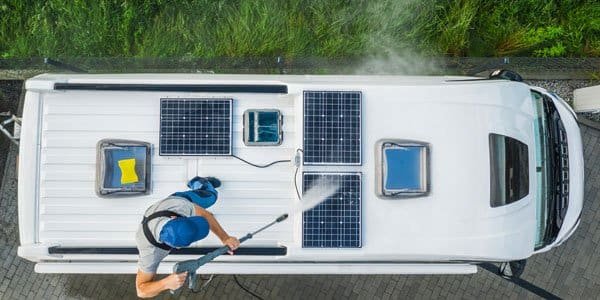
Getting your RV in Tip-Top Shape

Prep & Travel Tips for Snowbirds

RVC Loyalty
Rewards Program
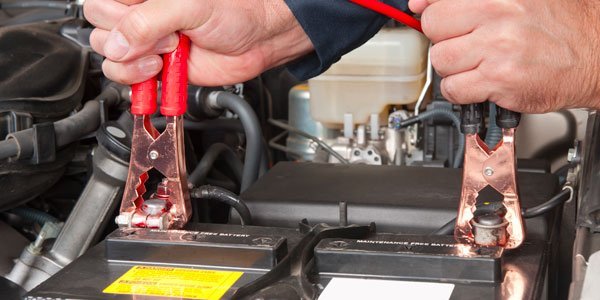
More About RV Battery Systems
Choosing the right battery and caring for it properly is an important task. There is tremendous value in having the right Premium RV Battery in your rig.

Tips for planning a great trip route
